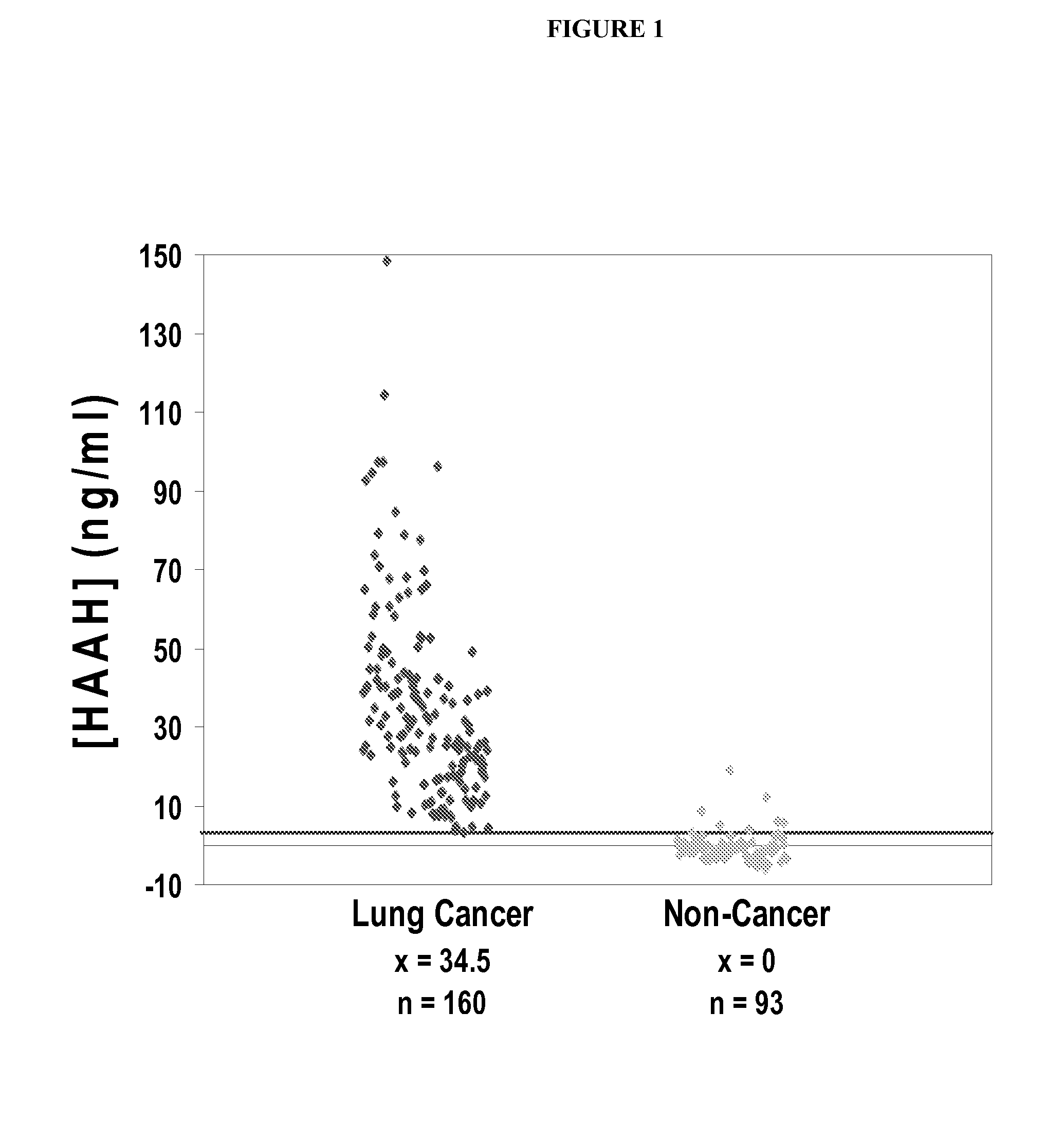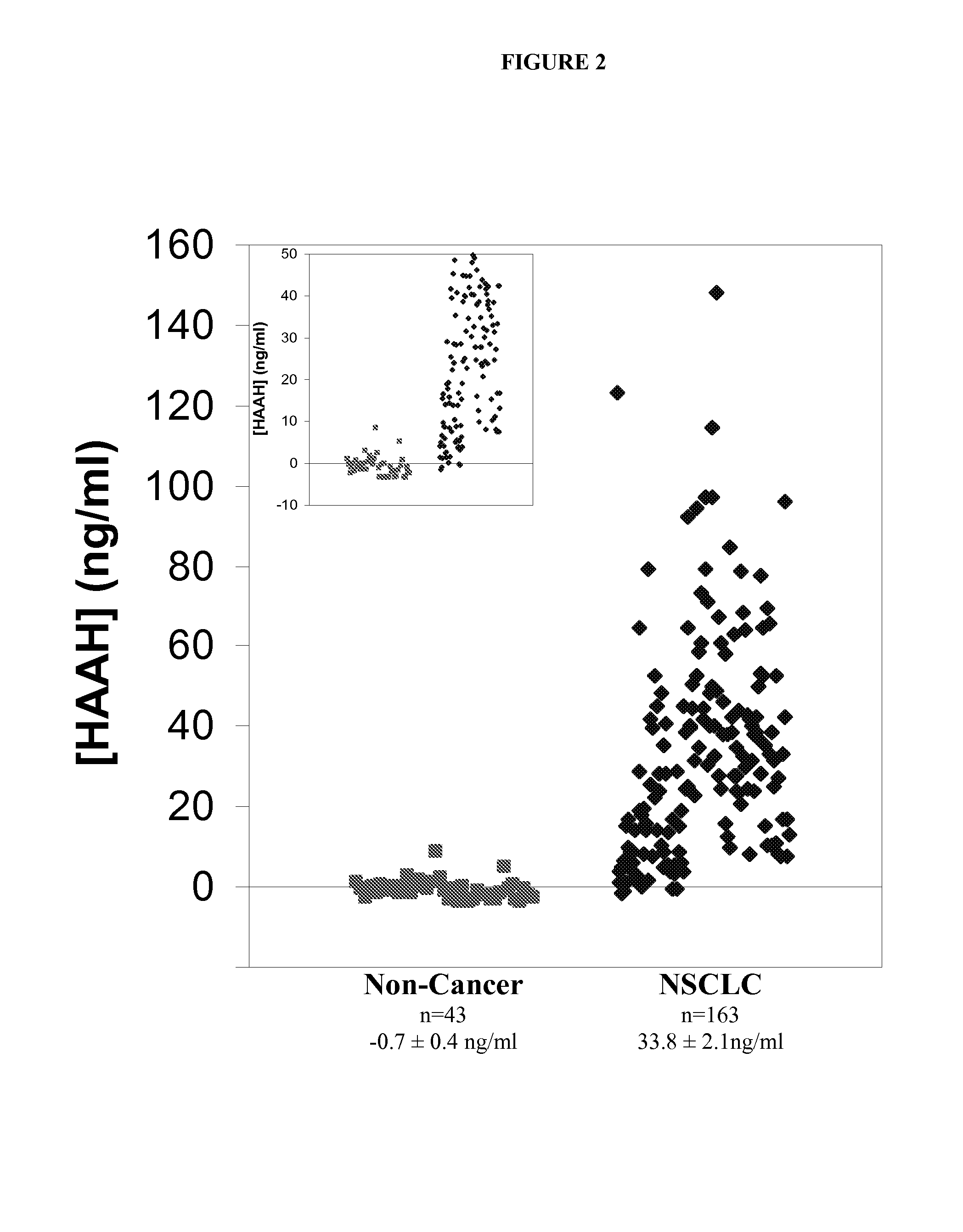Methods for the diagnosis of lung cancer
a lung cancer and method technology, applied in the field of lung cancer diagnosis, can solve the problems of high mortality worldwide, serological types of diagnostic methods, low sensitivity (especially in the early cancer stage), and high cost, and achieve the effect of improving the early detection of lung cancer
- Summary
- Abstract
- Description
- Claims
- Application Information
AI Technical Summary
Benefits of technology
Problems solved by technology
Method used
Image
Examples
example i
[0056]A large study was conducted using a double monoclonal (FB50 anti-HAAH antibodies) sandwich-type ELISA format with anti-AAH antibodies, providing detection and comparative quantification of HAAH in serum samples obtained from lung cancer patients, and control samples obtained from a pool of non-cancerous subjects (which included samples of cigarette smokers as well—“high risk controls”). The high risk controls were relevant to this study, because 87% of lung cancers are attributable to cigarette smoking, and associative parallels with recent reductions in rates of smoking have been reported in the literature.
Results
[0057]Increased levels of serum HAAH were found in 99% of patients with lung cancer (n=160). Quite strikingly, serum HAAH levels were found to be undetectable in individuals not known to have cancer (normal controls) (n=93, specificity=91%). See FIG. 1.
[0058]In the control subpopulation of 50 smokers not known to have cancer, the mean serum HAAH level was 0 ng / ml, wi...
example 2
[0060]The goal of this study was to provide further evidence of the clinical sensitivity and specificity of the diagnostic test of the present invention, as well as its unique utility as a screen for NSCLC (non-small cell lung cancer) in patients at increased risk of this disease, due to its ability to detect lung cancer as early as stage I of the disease.
[0061]Briefly, sera obtained from patients with a confirmed diagnosis of NSCLC (n=163) and individuals with no known history of cancer (n=43) were analyzed in a homologous antibody immunoassay for the detection of HAAH and used to determine a threshold value for the test that could serve to discriminate between subjects with and without NSCLC. A second set of patients, including subjects with stages I-IV NSCLC (n=60) and a control group of subjects with a history of moderate to heavy smoking (n=50), was used to further establish this cutoff value.
[0062]Briefly, the resulting data showed that sera from individuals with NSCLC had ele...
example 3
[0076]In this study, we first compared HAAH serum levels in NSCLC patients versus healthy control individuals. Subsequently, a follow-on study of this biomarker was made in order to determine whether levels of the HAAH protein in serum can be correlated to clinical response to treatment.
[0077]Using the double monoclonal antibody sandwich ELISA described above, HAAH levels were measured in the sera of 46 patients with non-small cell lung cancer (NSCLC) and 15 healthy controls. A subsequent study, which measured serum HAAH levels both before and after treatment in 22 of the patients was conducted.
Results
[0078]Serum HAAH was detectable and variable in 92% of NSCLC patients (n=43). Serum HAAH was found to be virtually undetectable in healthy donors. When patients were compared to healthy controls, the pretreatment median level of serum HAAH was significantly higher in NSCLC patients (P=0.00059). It was also noted that HAAH levels did not correlate with gender or age.
[0079]At the end of ...
PUM
 Login to View More
Login to View More Abstract
Description
Claims
Application Information
 Login to View More
Login to View More - R&D
- Intellectual Property
- Life Sciences
- Materials
- Tech Scout
- Unparalleled Data Quality
- Higher Quality Content
- 60% Fewer Hallucinations
Browse by: Latest US Patents, China's latest patents, Technical Efficacy Thesaurus, Application Domain, Technology Topic, Popular Technical Reports.
© 2025 PatSnap. All rights reserved.Legal|Privacy policy|Modern Slavery Act Transparency Statement|Sitemap|About US| Contact US: help@patsnap.com



